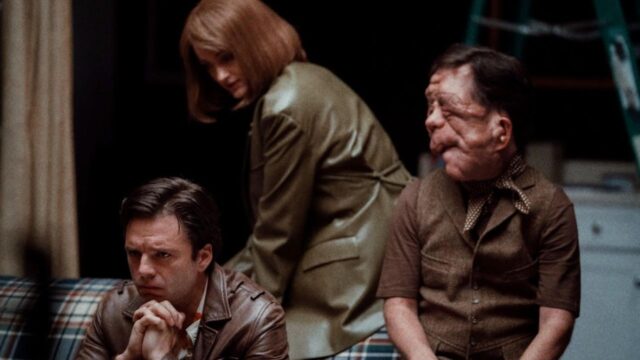Directed by Aaron Schimberg, A Different Man dives into the journey of Edward, a man living with neurofibromatosis—a rare genetic condition causing facial disfiguration. As an aspiring actor struggling to find his place in the world, Edward longs for connection, yet his condition makes him feel isolated and inadequate.
His life turns when he meets Ingrid, a playwright who shows him kindness. Hoping that his life will improve if he looks “normal,” Edward undergoes an experimental procedure that transforms his appearance. But his new life brings unexpected challenges and raises questions about identity, acceptance, and true happiness.
How Oswald’s Presence Shakes Edward’s Confidence
Before the procedure, Edward’s self-worth had been deeply affected by the reactions his appearance triggered in others. Even when people tried to avoid looking directly at him, their discomfort was clear, leading Edward to internalize this rejection.
Post-transformation, his life seems improved—he has a well-paying job, a nicer apartment, and a bit more confidence around women. But the arrival of Oswald, a naturally charismatic and confident man, stirs up Edward’s buried insecurities once more.
Unlike Edward, Oswald exudes charm and ease, handling even awkward situations gracefully. He is talented in various ways—he can perform accents, play instruments, and has a photographic memory, which makes him a star on stage.
Still grappling with insecurities despite his new appearance, Edward finds it hard to reconcile that while he used to attribute his problems to his looks, Oswald thrives despite his unconventional appearance. This dynamic makes Edward feel inadequate, pushing him to question whether his physical transformation was the solution.

What Drives Edward to Stab His Physical Therapist?
Edward’s jealousy turns into obsession, especially after he loses his acting role to Oswald. Obsessed with Oswald’s life—his success, his relationship with Ingrid, and even his family—Edward begins to unravel.
The situation escalates into a physical altercation with Oswald on stage, which ends in disaster for Edward. Injured and humiliated, he is left with his entire body in a cast.
Over time, however, Oswald and Ingrid take him in, caring for him through his recovery. When he finally begins physical therapy, his therapist makes a disparaging comment about Oswald’s appearance.
The remark triggers Edward, resurfacing all the negative feelings he once endured due to similar judgments about his looks. In a fit of anger, Edward attacks the therapist. This violent outburst reflects the pain, shame, and self-loathing Edward has bottled up for so long, making it evident that his transformation didn’t erase his deeper emotional scars.
How Prison Time Transforms Edward’s Perspective
Edward is sentenced to prison for his actions and spends years reflecting on his choices. This prolonged isolation forces him to confront his insecurities and actions, ultimately helping him gain perspective on his life.
By the time he’s released, Edward is a changed man—older, wiser, and free from the destructive envy that once consumed him. His newfound sense of self enables him to view Oswald not as a rival but as a friend.
Why Oswald Calls Edward by His Real Name
In a pivotal moment, Edward encounters Ingrid and Oswald again, who welcome him warmly. As they converse, Oswald refers to him as “Edward” instead of “Guy,” the alias he adopted post-transformation.
This casual use of his true name indicates a deeper shift. It suggests that Edward has revealed his identity to them at some point, and they’ve accepted him fully, with his past and present both acknowledged.
This moment symbolizes Edward’s journey toward self-acceptance.
After years of hiding and transforming himself, he finally allows himself to be known and accepted as Edward. Oswald’s affectionate words—calling him “my old friend” and affirming he hasn’t changed—reflect a deep camaraderie, free from judgment or superficial concerns.

Edward’s Smile: A Reflection of Inner Peace and Acceptance
In the final scene, Edward’s smile is not one of triumph or happiness but inner peace.
His smile represents a release from the burden of self-hate and a recognition that true acceptance doesn’t stem from physical appearance or external validation. Surrounded by friends who know him for who he truly is, Edward can finally embrace himself, insecurities and all.
Edward’s smile marks the end of his tumultuous journey, suggesting he has come to terms with his identity and found a sense of belonging.
No longer bound by envy or self-loathing, Edward’s smile is a subtle yet powerful indication of his hard-won peace and acceptance.
By embracing his real identity, Edward reaches a place of genuine connection and understanding—a fitting conclusion to his complex story of transformation and self-discovery.
About A Different Man
A Different Man is a 2024 American black comedy psychological thriller film written and directed by Aaron Schimberg, starring Sebastian Stan, Renate Reinsve, and Adam Pearson.
The film premiered at Sundance Film Festival on January 21, 2024, and it was released in the United States on September 20, 2024.








No Comments on A Different Man Ending Explained: Edward’s Smile and Its Deeper Meaning